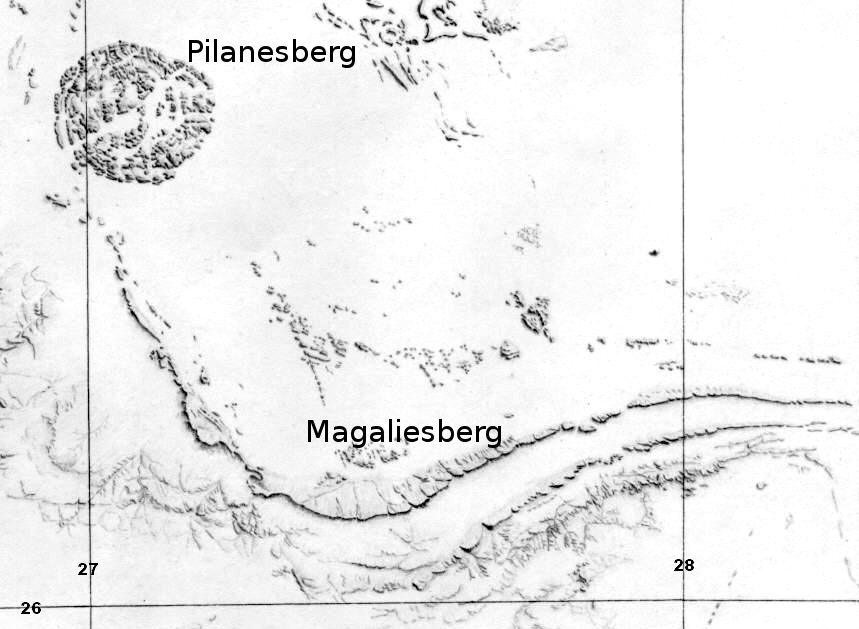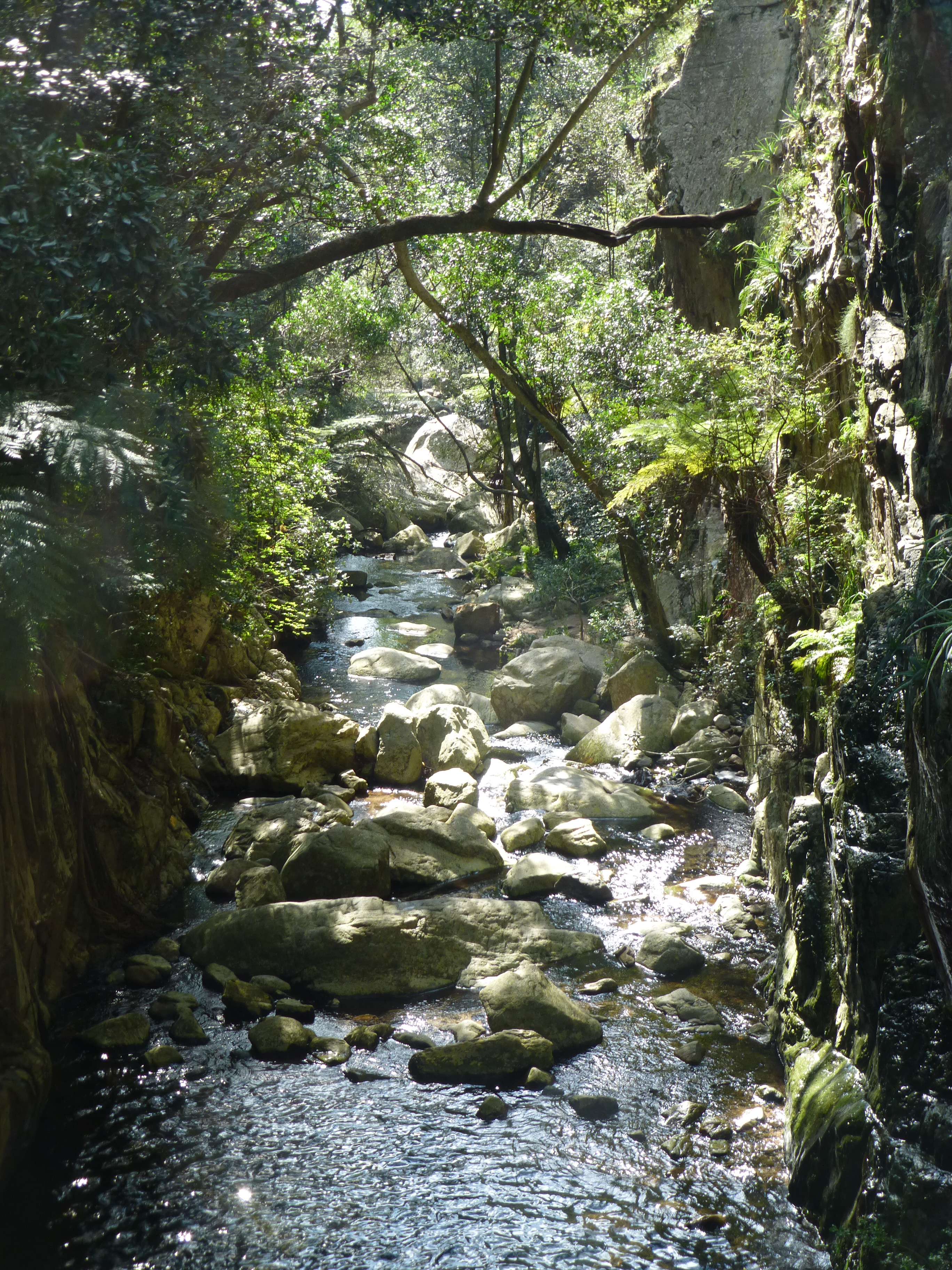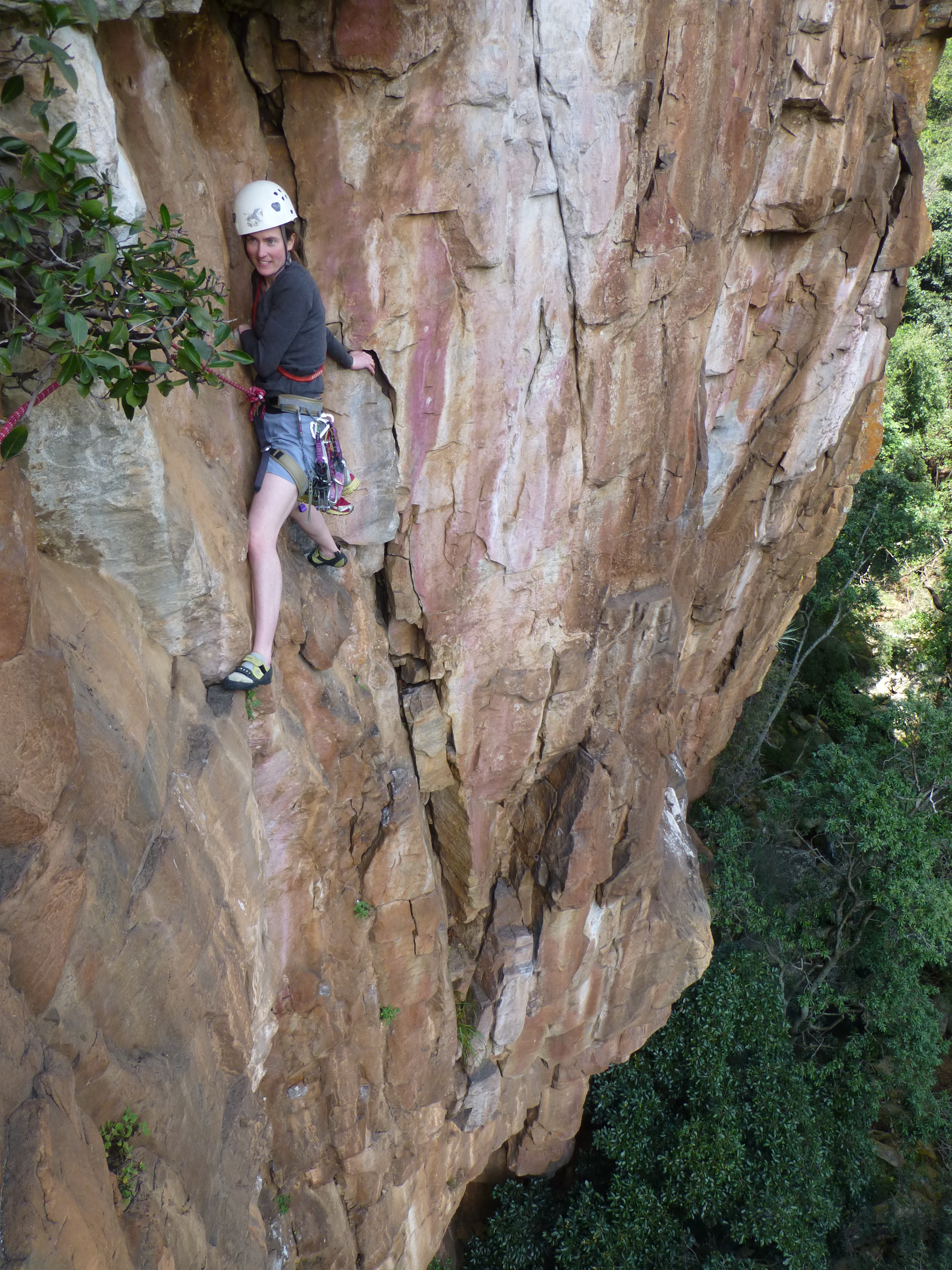Magaliesberg Nature Reserve on:
[Wikipedia]
[Google]
[Amazon]

 The Magaliesberg (historically also known as ''Macalisberg'' or ''Cashan Mountains'') of northern South Africa, is a modest but well-defined mountain range composed mainly of quartzites. It rises at a point south of the Pilanesberg (and the Pilanesberg National Park) to form a curved prominence that intersects suburban Pretoria before it peters out some to the east, just south of Bronkhorstspruit. The highest point of the Magaliesberg is reached at Nooitgedacht, about above sea level. A cableway reaching to the top of the mountain range is located at Hartbeespoort Dam, providing sweeping views of the Magaliesberg and surrounding area.
The Magaliesberg (historically also known as ''Macalisberg'' or ''Cashan Mountains'') of northern South Africa, is a modest but well-defined mountain range composed mainly of quartzites. It rises at a point south of the Pilanesberg (and the Pilanesberg National Park) to form a curved prominence that intersects suburban Pretoria before it peters out some to the east, just south of Bronkhorstspruit. The highest point of the Magaliesberg is reached at Nooitgedacht, about above sea level. A cableway reaching to the top of the mountain range is located at Hartbeespoort Dam, providing sweeping views of the Magaliesberg and surrounding area.
 The range forms a natural barrier between the lower lying Bushveld to the north and the cooler Highveld to the south. The range receives rainfall in summer in the form of thunderstorms, with an average of annually. In winter, frost occurs frequently in the valleys on the southern side of the mountain, but almost never on the northern slopes.
The range forms a natural barrier between the lower lying Bushveld to the north and the cooler Highveld to the south. The range receives rainfall in summer in the form of thunderstorms, with an average of annually. In winter, frost occurs frequently in the valleys on the southern side of the mountain, but almost never on the northern slopes.
 The area around the Magaliesberg range has seen extremely lengthy occupation by humans dating back at least 2 million years to the earliest hominin species (such as '' Mrs Ples'') in and around the
The area around the Magaliesberg range has seen extremely lengthy occupation by humans dating back at least 2 million years to the earliest hominin species (such as '' Mrs Ples'') in and around the

 After nearly a decade of lobbying and sustained efforts by a small committee of dedicated environmentalists, the Magaliesberg has been declared a World Biosphere Reserve.
The announcement was made on 9 June 2015 in Paris by the International Coordinating Council of the Programme on Man and the Biosphere (MAB). This is a UNESCO programme that aims to build a supportive and sustainable relationship between people and their environments. In effect, this means a specific focus on safeguarding natural ecosystems through innovative approaches to economic development.
The World Network of Biosphere Reserves, which Magaliesberg now joins, counts 631 biosphere reserves in 119 countries.
“We are delighted with this final acknowledgement of the unique nature of the Magaliesberg and the powerful contribution it is making to our country, to the ecosystem services in Gauteng and the North West and the communities it nurtures over an extensive area,” said Paul Fatti, chair of the Magaliesberg Biosphere Initiative Group (MBIG) that has been lobbying authorities since 2007 to support the establishment of the biosphere.
Vincent Carruthers, past chair of MBIG and renowned author of ''The Magaliesberg'', the most authoritative study of the mountain range, said that this announcement was the culmination of a campaign that began in 2006. “I'm most grateful there is now international recognition of this great mountain range that has witnessed the whole span of life, from its very origins,” he said. “The Magaliesberg is almost 100 times older than Mount Everest and half the age of the earth, a unique treasure for us in this part of Africa.”
After nearly a decade of lobbying and sustained efforts by a small committee of dedicated environmentalists, the Magaliesberg has been declared a World Biosphere Reserve.
The announcement was made on 9 June 2015 in Paris by the International Coordinating Council of the Programme on Man and the Biosphere (MAB). This is a UNESCO programme that aims to build a supportive and sustainable relationship between people and their environments. In effect, this means a specific focus on safeguarding natural ecosystems through innovative approaches to economic development.
The World Network of Biosphere Reserves, which Magaliesberg now joins, counts 631 biosphere reserves in 119 countries.
“We are delighted with this final acknowledgement of the unique nature of the Magaliesberg and the powerful contribution it is making to our country, to the ecosystem services in Gauteng and the North West and the communities it nurtures over an extensive area,” said Paul Fatti, chair of the Magaliesberg Biosphere Initiative Group (MBIG) that has been lobbying authorities since 2007 to support the establishment of the biosphere.
Vincent Carruthers, past chair of MBIG and renowned author of ''The Magaliesberg'', the most authoritative study of the mountain range, said that this announcement was the culmination of a campaign that began in 2006. “I'm most grateful there is now international recognition of this great mountain range that has witnessed the whole span of life, from its very origins,” he said. “The Magaliesberg is almost 100 times older than Mount Everest and half the age of the earth, a unique treasure for us in this part of Africa.”
Magaliesberg Protection AssociationMining Threat to UNESCO Magaliesberg Biosphere
{{Authority control Mountain ranges of South Africa Climbing areas of South Africa Landforms of Gauteng Landforms of North West (South African province)

 The Magaliesberg (historically also known as ''Macalisberg'' or ''Cashan Mountains'') of northern South Africa, is a modest but well-defined mountain range composed mainly of quartzites. It rises at a point south of the Pilanesberg (and the Pilanesberg National Park) to form a curved prominence that intersects suburban Pretoria before it peters out some to the east, just south of Bronkhorstspruit. The highest point of the Magaliesberg is reached at Nooitgedacht, about above sea level. A cableway reaching to the top of the mountain range is located at Hartbeespoort Dam, providing sweeping views of the Magaliesberg and surrounding area.
The Magaliesberg (historically also known as ''Macalisberg'' or ''Cashan Mountains'') of northern South Africa, is a modest but well-defined mountain range composed mainly of quartzites. It rises at a point south of the Pilanesberg (and the Pilanesberg National Park) to form a curved prominence that intersects suburban Pretoria before it peters out some to the east, just south of Bronkhorstspruit. The highest point of the Magaliesberg is reached at Nooitgedacht, about above sea level. A cableway reaching to the top of the mountain range is located at Hartbeespoort Dam, providing sweeping views of the Magaliesberg and surrounding area.
Geology
The Magaliesberg has ancient origins. Its composition is ascribed to successive geological processes over a very protracted history. Its quartzites,shale
Shale is a fine-grained, clastic sedimentary rock formed from mud that is a mix of flakes of clay minerals (hydrous aluminium phyllosilicates, e.g. kaolin, Al2 Si2 O5( OH)4) and tiny fragments (silt-sized particles) of other minerals, especial ...
s, chert and dolomite were deposited as sediments in an inland basin on top of a 3 billion year old Archaean Basement
A basement or cellar is one or more floors of a building that are completely or partly below the ground floor. It generally is used as a utility space for a building, where such items as the furnace, water heater, breaker panel or fuse box, ...
Complex, known as the Kaapvaal Craton. This process of sedimentation lasted for about 300 million years. About 2 billion years ago, a massive upwelling of molten magma resulted in what is now known as the Bushveld Igneous Complex. The enormous weight of this intrusion depressed the sediments that lay beneath and tilted the sediments along the edges so that the broken escarpments faced outward and upward, and the gentler dip slopes inward. During the same period, these sediments were fractured and igneous intrusions
Igneous rock (derived from the Latin word ''ignis'' meaning fire), or magmatic rock, is one of the three main rock types, the others being sedimentary and metamorphic. Igneous rock is formed through the cooling and solidification of magma or ...
of dolerite filled the cracks. With the passage of time these intrusions eroded, especially on the dip slopes, forming deep kloofs or ravines providing rock-climbing potential to modern man. This large dog-leg-shaped area is now termed the Transvaal Basin and includes the lofty escarpment of the Transvaal Drakensberg overlooking the Lowveld in the eastern part of the country. Massive outpourings of igneous material–volcanic lava–of the much younger Karoo Supergroup later covered the Transvaal Basin, but this was subsequently eroded so that it only remains along the Transvaal Basin's southern rim.
Climate
 The range forms a natural barrier between the lower lying Bushveld to the north and the cooler Highveld to the south. The range receives rainfall in summer in the form of thunderstorms, with an average of annually. In winter, frost occurs frequently in the valleys on the southern side of the mountain, but almost never on the northern slopes.
The range forms a natural barrier between the lower lying Bushveld to the north and the cooler Highveld to the south. The range receives rainfall in summer in the form of thunderstorms, with an average of annually. In winter, frost occurs frequently in the valleys on the southern side of the mountain, but almost never on the northern slopes.
History
 The area around the Magaliesberg range has seen extremely lengthy occupation by humans dating back at least 2 million years to the earliest hominin species (such as '' Mrs Ples'') in and around the
The area around the Magaliesberg range has seen extremely lengthy occupation by humans dating back at least 2 million years to the earliest hominin species (such as '' Mrs Ples'') in and around the Sterkfontein
Sterkfontein (Afrikaans for ''Strong Spring'') is a set of limestone caves of special interest to paleo-anthropologists located in Gauteng province, about northwest of Johannesburg, South Africa in the Muldersdrift area close to the town of K ...
Caves, which lie at the Cradle of Humankind
The Cradle of Humankind is a paleoanthropological site and is located about northwest of Johannesburg, South Africa, in the Gauteng province. Declared a World Heritage Site by UNESCO in 1999, the site is home to the largest concentration of ...
World Heritage Site, close to the town of Magaliesburg.
The earliest known name for the Magaliesberg mountains is Dithaba Diloka. This is a local seTswana name in reference to the abundance of Heteropogon contortus which grows in the area. However it seems this name would have only been used by neighbouring Sotho-Tswana_peoples coming to and from the Magaliesberg mountains. Local resident Tswana tribes referred to it simply as Dithaba ''"The mountains"''.
The first European
European, or Europeans, or Europeneans, may refer to:
In general
* ''European'', an adjective referring to something of, from, or related to Europe
** Ethnic groups in Europe
** Demographics of Europe
** European cuisine, the cuisines of Europe ...
explorers who came to the area recorded the mountains being called the ''"Cashan"'' or ''"Kashan"'' mountains. This was a corruption of the name of a powerful chief of the BaKwena ba Mmatau
The Bakoena or Bakwena ("those who venerate the crocodile") are a large clan in Southern Africa. They form part of the Sotho-Tswana Bantu people and can be found in different countries such as Lesotho, Botswana, South Africa, Zimbabwe and Eswa ...
whose name was Kgwasane wa Sekano ''(Kgwasane, son of Sekano)''.
In the mid-1800s the mountain range became known as Magaliesberg ''(lit. Mogale's mountain)'' after Kgosi Mogale. Mogale means ''"sharp"'' or ''"brave"'' person, but is also the common word for a warrior or Tswana soldier, in Sotho bogale means ''"sharp"'' and mogale is ''"brave"''. Similarly, the mountain range to the north, near Sun City, Pilanesberg, was named after the local Bakgatla chiefs, who were called Pilane.
In 1822, Shaka, the leader of the Zulu Kingdom
The Zulu Kingdom (, ), sometimes referred to as the Zulu Empire or the Kingdom of Zululand, was a monarchy in Southern Africa. During the 1810s, Shaka established a modern standing army that consolidated rival clans and built a large following ...
, sent his most trusted commander, Mzilikazi, to conquer the Sotho tribes of the region. After accomplishing this task, Mzilikazi decided to break away from Shaka and found his own nation, the Matabele. As he feared an attack from Shaka if he returned home, he settled in the Magaliesberg region.
On 17 January 1837, after some Voortrekkers had been attacked and killed by Mzilikazi's impis, they counter-attacked and, under the leadership of Hendrik Potgieter and Gerrit Maritz, and with the help of local Sotho- Tswana chiefdoms, drove the Matabeles north across the Limpopo River. Because the re-conquest of the region was a cooperative venture of the Boers and the Sotho-Tswana against the Matabele, the Boers and Sotho-Tswana had friendly relations at the beginning of white settlement. These friendly relations are reflected in the name of the main Boer town, Rustenburg (''lit''. resting town), because it seemed to them that they would not have to engage in any more fighting against African communities. The Boers initially settled south of the Magaliesberg in the Highveld, leaving the Bushveld north of the Magaliesberg mostly to their Sotho-Tswana friends and allies; according to Sarah Heckford's memoir, ''A Lady Trader in the Transvaal'', the Boers would move into the Bushveld to visit their Sotho-Tswana neighbors during the winter. According to oral testimony by Tswana headmen recorded around the turn of the 20th century, many individual Boers formed close friendships with prominent individual Tswana headmen and chiefs, especially for the purpose of forming hunting parties to gather ivory and other products from further north. Subsequently the Boers began settling in the valleys of the Magaliesberg Range and in the Bushveld north of the Magaliesberg, and turned the region into some of the most productive farmland in South Africa, while displacing their former allies, confining them to locations and reserves.
The area saw some heavy fighting during the Second Anglo-Boer War. The Boers, being extremely familiar with the mountains, used secret pathways across the mountains to launch guerrilla attacks on the British soldiers
The British Army is the principal Army, land warfare force of the United Kingdom, a part of the British Armed Forces along with the Royal Navy and the Royal Air Force. , the British Army comprises 79,380 regular full-time personnel, 4,090 Br ...
. In response, the British forces built blockhouse
A blockhouse is a small fortification, usually consisting of one or more rooms with loopholes, allowing its defenders to fire in various directions. It is usually an isolated fort in the form of a single building, serving as a defensive stro ...
s on top of the mountains in order to restrict the movement of the Boer forces; ruins of these structures are still to be seen on the mountain.
Control of the Magaliesberg Mountain Range was of great importance to both the Boer and the British forces, especially the two routes between Pretoria and Rustenburg, which crossed it at Silkaatsnek and Kommandonek, respectively. As a result, many battles, such as the battles of Buffelspoort, Nooitgedacht and Olifantsnek were fought in the area.
After the war, farms in the area were reoccupied and farming was resumed, tobacco and citrus being particularly successful.
In 1923 the Hartbeespoort Dam, situated in one of the valleys of the range, was completed. It became a popular holiday and weekend destination for the inhabitants of Johannesburg and Pretoria, and the villages of Hartbeespoort and Kosmos
The cosmos (, ) is another name for the Universe. Using the word ''cosmos'' implies viewing the universe as a complex and orderly system or entity.
The cosmos, and understandings of the reasons for its existence and significance, are studied in ...
developed as a result.
At present, the Magaliesberg area is still largely agricultural
Agriculture or farming is the practice of cultivating Plant, plants and livestock. Agriculture was the key development in the rise of Sedentism, sedentary human civilization, whereby farming of Domestication, domesticated species created food ...
, although tourism is a rapidly growing industry in the area.
Kgaswane Mountain Reserve is a nature reserve above Rustenburg covering of the Magaliesberg.
Numerous smaller reserves, private and state, are to be found along the length of the range.
Magaliesberg Biosphere Reserve

Rock climbing
The Magaliesberg mountains offer excellentrock climbing
Rock climbing is a sport in which participants climb up, across, or down natural rock formations. The goal is to reach the summit of a formation or the endpoint of a usually pre-defined route without falling. Rock climbing is a physically and ...
opportunities, spread across its many kloofs and escarpments. The climbing is mostly traditional, with a small number of sport climbing
Sport climbing (or Bolted climbing) is a form of rock climbing that relies on permanent anchors (or bolts), permanently fixed into the rock for climber protection, in which a rope that is attached to the climber is clipped into the anchors to ...
venues and hundreds of routes across a wide range of grades
Grade most commonly refers to:
* Grade (education), a measurement of a student's performance
* Grade, the number of the year a student has reached in a given educational stage
* Grade (slope), the steepness of a slope
Grade or grading may also r ...
. The relatively mild climate allows year-round climbing.
References
External links
Magaliesberg Protection Association
{{Authority control Mountain ranges of South Africa Climbing areas of South Africa Landforms of Gauteng Landforms of North West (South African province)